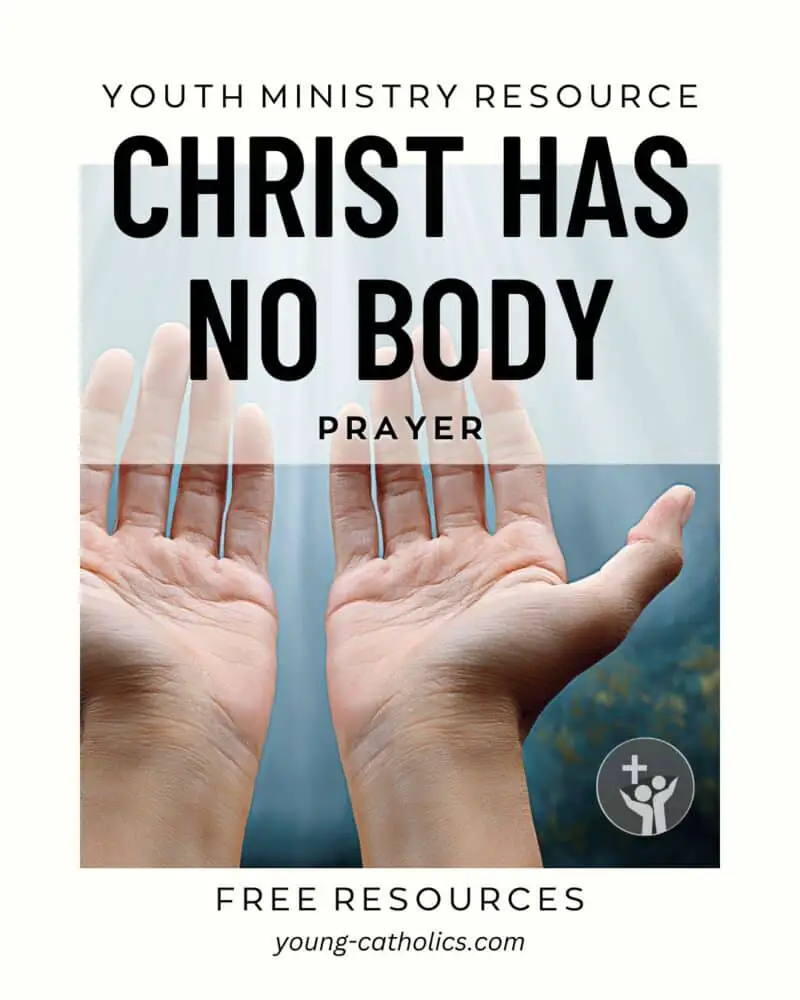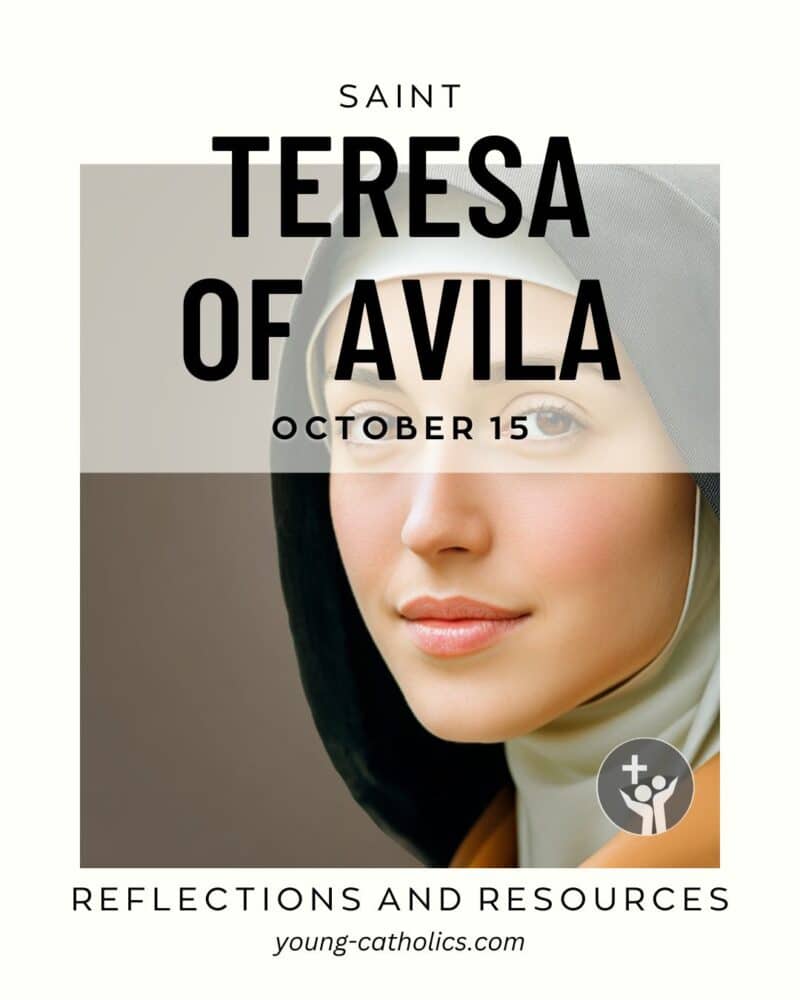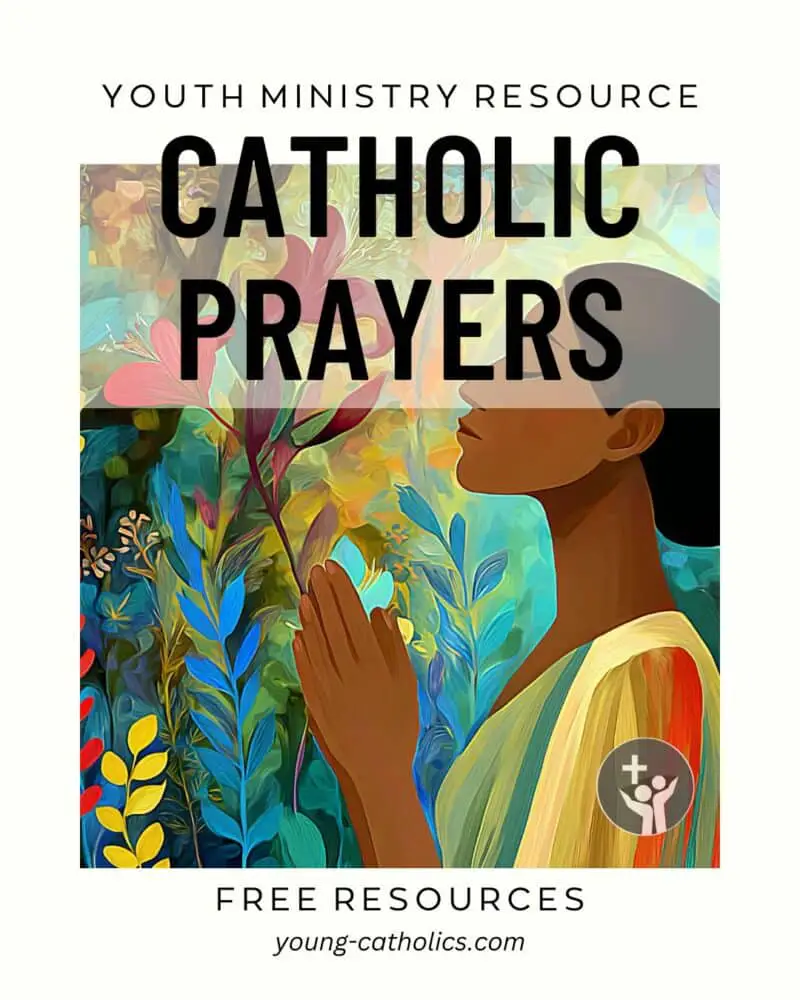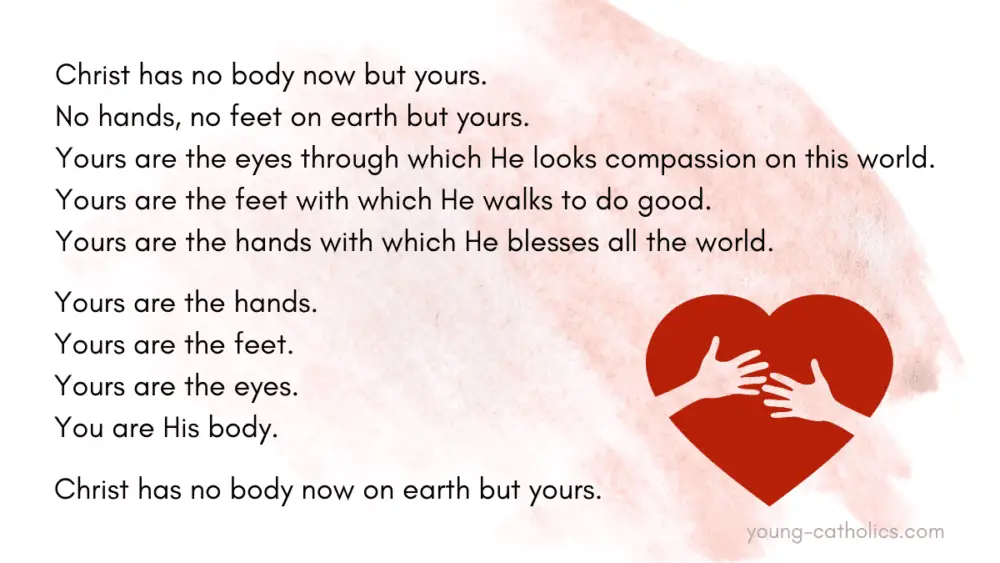Christ Has No Body Prayer

The Christ Has No Body prayer reminds us that we are called to live out our faith through action. Though often linked to St. Teresa of Avila, it is not found in her writings. Still, the prayer reflects her message that Christ works through us. It speaks in simple words about a deep truth: we are Christ’s body on earth.
This prayer teaches that Jesus relies on us to continue His work. We are His hands that help, His feet that serve, and His eyes that see with love. The words are clear and direct. They remind us that following Christ is not only about prayer and belief. It is also about doing good and caring for others.
The message fits well with the teachings of the Church. Scripture tells us we are members of the Body of Christ. This prayer turns that teaching into a call to action. It helps us think about how we can live out our faith in everyday life.
The Christ Has No Body prayer is useful in many settings. It can be shared in the classroom, in youth ministry, or at home. It invites young people and adults to think about how they can serve others. It encourages all of us to live as Christ would live, using our gifts and actions to show His love.
The Prayer with Unknown Roots but a Clear Message
The Christ Has No Body prayer is often linked to St. Teresa of Avila. Many people believe she wrote it. But it does not appear in her writings. Most likely, someone else wrote it later, using her teachings as inspiration. St. Teresa often spoke about how Christ works through us. This prayer puts that idea into simple and clear words.
The style of the prayer is easy to follow. It starts with a strong message: Christ has no body on earth but ours. Then it repeats that we are His hands, feet, and eyes. The short lines and repeated phrases help us remember the message. The rhythm of the prayer makes it feel like something you could say in prayer, in class, or during a youth group reflection.
This prayer is not long or fancy. But it teaches something important. We are part of Christ’s mission. The simple words remind us that faith is not only what we believe. It is also what we do. The prayer gives us a clear reminder to live like Christ and serve others.
Even though we do not know exactly who wrote it, the prayer has touched many lives. It is shared in churches, schools, and homes. Its meaning is easy to understand and hard to forget. That’s why it remains a popular prayer, even today.
Living the Mission
The Christ Has No Body prayer is closely tied to the Bible. It reminds us of what Saint Paul wrote in 1 Corinthians 12:27: “Now you are the body of Christ, and each one of you is a part of it.” This verse teaches that each Christian has a role. We are all part of Christ’s work on earth. The prayer helps us remember that we are His hands, feet, and eyes in the world today.
This prayer also connects to what Jesus said in Matthew 25:40. “Whatever you did for one of the least of these brothers and sisters of mine, you did for me.” When we help others, we serve Christ. The prayer helps young people see this clearly. It gives them a simple way to understand that faith is not just words. It is action.
In youth ministry, this prayer can guide young people to live their faith. It gives them a clear picture of how they can follow Jesus. It also helps leaders talk about service, kindness, and compassion in a way that makes sense. The prayer is short and easy to remember, but it leads to deeper thinking and real action.
The Catechism of the Catholic Church says, “The Church is the Body of Christ. Through the Spirit and his action in the sacraments, above all the Eucharist, this unity is brought about” (CCC 805). This prayer helps young people understand what this means. It shows them that they are part of something bigger. They are called to live like Christ and to love others with their actions.
The Christ Has No Body Prayer
Christ has no body now but yours
No hands, no feet on earth but yours
Yours are the eyes through which He looks
Compassion on this world
Yours are the feet with which He walks to do good
Yours are the hands with which He blesses all the world
Yours are the hands
Yours are the feet
Yours are the eyes
You are His body
Christ has no body now on earth but yours
More Resources

Listen to the Christ Has No Body Prayer in song
Get daily reflections based on the writing of St. Teresa of Avila

St. Teresa of Avila
Saint Teresa of Avila was a Spanish nun who lived in the 1500s. She worked to bring renewal to the Church and helped reform the Carmelite order. She believed in living simply, praying deeply, and trusting God in all things. She started new convents that followed her way of life.
She also wrote books about prayer and faith that are still read today. Her teachings help people grow closer to God through quiet prayer and reflection. Though she likely did not write the Christ Has No Body Prayer, it reflects her message that Christ works through us.

More Catholic Prayers
The Christ Has No Body Prayer is just one of many simple and meaningful prayers you can find on our Catholic Prayers page. Whether you are looking for something to share with youth, to use at home, or to pray quietly on your own, there are many options to explore.
Visit our Catholic Prayers page to discover prayers for different times and needs. You’ll find traditional favorites and other prayers that focus on service, love, and growing in faith. These prayers are easy to use and great for youth ministry, catechism, or personal reflection.
Social Media Graphics and Bulletin Artwork
If you would like an image to be made available as a specific product (card, poster, mug, etc.) or as an extra high resolution image for personal use just post a comment about what you want and we will create a link to our online store for you.
Open Hands for Christ

This powerful image of open hands lifted to the light is now available for download on our website. It is ideal for bulletins, newsletters, and youth ministry materials. Use it to highlight the call to be the hands of Christ in the world, serving others with love and compassion.
Share it with your parish or group to inspire service, prayer, and reflection. Let this image remind your community that Christ works through us when we open our hands and hearts to His mission.
Paid subscribers may download a large copy this digital artwork without watermarks, suitable for use in bulletins, social media, newsletters, etc., free of charge by clicking here. You must be logged in as a paid subscriber to access the file.
Only current paid subscribers have the rights to use the artwork.
Questions and Answers about the Christ Has No Body Prayer
Who wrote the Christ Has No Body Prayer?
The Christ Has No Body Prayer is often linked to St. Teresa of Avila. But there is no proof that she wrote it. The prayer might be based on her teachings, but the true author is unknown.
What does the Christ Has No Body Prayer mean?
This prayer reminds us that Jesus works through us. We are His hands, feet, and eyes on earth. It teaches that we should live like Christ by helping others and showing love.
Is the Christ Has No Body Prayer in the Bible?
No, the Christ Has No Body Prayer is not found in the Bible. But the message of the prayer fits with Scripture. It reflects verses like 1 Corinthians 12:27, which says we are the Body of Christ.
How can I use the Christ Has No Body Prayer in youth ministry?
You can use this prayer in group prayer, retreats, or service talks. It helps youth understand that faith involves action. It also works well with lessons on service and the Body of Christ.
Why is the Christ Has No Body Prayer important for Catholics?
The Christ Has No Body Prayer reminds us that being Catholic means more than just believing. It means doing. The prayer teaches that we are called to love and serve others as Jesus did.
Can children understand the Christ Has No Body Prayer?
Yes. The words are simple, and the message is clear. Children can learn that they are part of Christ’s work in the world. It’s a good way to teach young people how to live their faith.
A Prayer for Action
The Christ Has No Body Prayer reminds us that Jesus works through us. It teaches that we are His hands, feet, and eyes in the world today. This prayer helps us think about how we treat others and how we live our faith each day.
Though often linked to St. Teresa of Avila, the Christ Has No Body Prayer is not found in her writings. It likely came from someone inspired by her teachings. The message is simple: Christ needs us to carry on His mission of love and service.
The prayer uses short lines and repeats key ideas. This makes it easy to remember and easy to share. It is often used in youth ministry and catechism because of its clear message and strong call to serve others.
The Christ Has No Body Prayer is a good way to teach that faith is more than just words. It helps us think about how we can act like Christ in our daily lives. It invites us to live with purpose, kindness, and care.
Your Turn
Have you used the Christ Has No Body Prayer in your family, class, or ministry? Has it helped you or others think about how to live more like Christ? We’d love to hear how this prayer has touched your life.
Please share your thoughts in the comment section below. Your story may help others understand this prayer more deeply and find ways to live it out in their own lives.



Leave a Reply